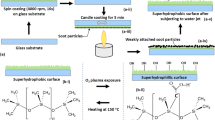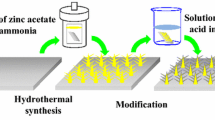Abstract
We present a facile one-step method to fabricate superhydrophobic Ag surface by electrodeposition without using any low surface energy reagent. The water contact angle of the prepared surface is 167.1° and the sliding angle is only 0.5° after heat treatment. It is demonstrated by the field emission scanning electron microscopy (FESEM), X-ray diffraction (XRD) and X-ray photoelectron spectroscopy (XPS) analyses that the dendrites of rough micro-nanostructure combined with the spontaneously adsorbed hydrocarbon make the surface exhibit superhydrophobicity. However, the superhydrophobic Ag surface becomes superhydrophilic when the surface is irradiated by UV light for several hours. It recovers superhydrophobicity after further heat treatment and can successfully implement the reversible wettability transition between superhydrophobicity and superhydrophilicity for several cycles.
摘要
本文采用简单的电沉积法制备出无需低表面能试剂修饰的超疏水银表面. 镀银表面经过热处理后与水滴的接触角达到167.1°而滚动角仅为0.5°. 通过FESEM, XRD以及XPS分析表明, 制备的微米/纳米级粗糙结构的银表面吸附了空气中的碳氢化合物导致表面具有超疏水性. 当用紫外光照射表面几个小时后, 表面会从超疏水性转变为超亲水性. 然而, 热处理后表面又恢复超疏水性能. 重复紫外光照射和热处理过程, 镀银表面可以实现超疏水和超亲水之间的多次转换.
Similar content being viewed by others
References
Liu KS, Tian Y, Jiang L. Bio-inspired superoleophobic and smart materials: design, fabrication, and application. Prog Mater Sci, 2013, 58: 503–564
Darmanin T, Guittard F. Wettability of conducting polymers: from superhydrophilicity to superoleophobicity. Prog Polym Sci, 2014, 39: 656–682
Bellanger H, Darmanin T, Givenchy ET, et al. Chemical and physical pathways for the preparation of superoleophobic surfaces and related wetting theories. Chem Rev, 2014, 114: 2694–2716
Liu K, Cao M, Fujishima A, et al. Bio-inspired titaniumdioxide materials with special wettability and their applications. Chem Rev, 2014, 114: 10044–10094.
Liu HL, Zhang PC, Liu MJ, et al. Organogel-based thin films for self-cleaning on various surfaces. Adv Mater, 2013, 25: 4477–4481
Guo ZG, Zhou F, Hao JC, et al. Stable biomimetic super-hydrophobic engineering materials. J AmChemSoc, 2005, 127: 15670–15671
Ou JF, Hu WH, Xue MS, et al. One-step solution immersion process to fabricate superhydrophobic surfaces on light alloys. ACS Appl Mater Inter, 2013, 5: 9867–9871
Ou JF, Liu MZ, Li W, et al. Corrosion behavior of superhydrophobic surfaces of Ti alloys in NaCl solutions. Appl Surf Sci, 2012, 258: 4724–4728
Ou JF, Hu WH, Wang Y, et al. Construction and corrosion behaviors of a bilayer superhydrophobic film on copper substrate. Surf Interface Anal, 2013, 45: 698–704
He M, Wang J, Li H, et al. Super-hydrophobic surfaces to condensed micro-droplets at temperatures below the freezing point retard ice/frost formation. Soft Matter, 2011, 7: 3993–4000
Davis A, Yeong YH, Steele A, et al. Superhydrophobic nanocomposite surface topography and ice adhesion. ACS Appl Mater Inter, 2014, 6: 9272–9279
Lv JY, Song YL, Jiang L, Wang JJ. Bio-inspired strategies for antiicing. ACS Nano, 2014, 8: 3152–3169
Zhang QL, He M, Chen J, et al. Anti-icing surfaces based on enhanced self-propelled jumping of condensed water microdroplets. Chem Commun, 2013, 49: 4516–4518
Wang FJ, Xue MS, Li W, et al. In situ separation and collection of oil from water surface via a novel superoleophilic and superhydrophobic oil containment boom. Langmuir, 2014, 30: 1281–1289
Wang FJ, Xue MS, Li W, et al. Superhydrophobic and superoleophilic miniature device for the collection of oils from water surfaces. J Phys ChemC, 2014, 118: 6344–6351
Li J, Li DM, Yang YX, et al. A prewetting induced underwater superoleophobic or underoil (super) hydrophobic waste potato residue-coated mesh for selective efficient oil/water separation. Green Chem, 2016, 18: 541–549
Li Y, Huang XJ, Heo SH, et al. Superhydrophobic bionic surfaces with hierarchical microsphere/SWCNT composite arrays. Langmuir, 2007, 23: 2169–2174
Li Y, Lee EJ, Cho SO. Superhydrophobic coatings on curved surfaces featuring remarkable supporting force. J Phys Chem C, 2007, 111: 14813–14817
Chen Y, Zhang Y, Shi L, et al. Transparent superhydrophobic/superhydrophilic coatings for self-cleaning and anti-fogging. Appl Phys Lett, 2012, 101: 033701
Ou JF, Hu WH, Xue MS, et al. Superoleophobic textured copper surfaces fabricated by chemical etching/oxidation and surface fluorination. ACS Appl Mater Inter, 2013, 5: 10035–10041
Ueda E, Levkin PA. Emerging applications of superhydrophilic-superhydrophobic micropatterns. Adv Mater, 2013, 25: 1234–1247
Valipour N, Birjandi FC, Sargolzaei J. Super-non-wettable surfaces: a review. Colloid Surface A, 2014, 448: 93–106
Ma M, Hill RM. Superhydrophobic surfaces. Curr Opin Colloid In, 2006, 11: 193–202
Yang J, Yin L, Tang H, et al. Polyelectrolyte-fluorosurfactant complex-based meshes with superhydrophilicity and superoleophobicity for oil/water separation. Chem Eng J, 2015, 268: 245–250
Xue MS, Peng N, Li CQ, et al. Enhanced superhydrophilicity and thermal stability of ITO surface with patterned ceria coatings. Appl Surf Sci, 2015, 329: 11–16
Srisitthiratkul C, Yaipimai W, Intasanta V. Environmental remediation and superhydrophilicity of ultrafine antibacterial tungsten oxide-based nanofibers under visible light source. Appl Surf Sci, 2012, 259: 349–355
Dhumale VA, Shah PA, Mulla IS, et al. Switching of hydrophilic to ultra hydrophilic properties of flower-like gold nanostructures. Appl Surf Sci, 2010, 256: 4192–4195
Chang CJ, Hung ST, Nanosci J. Wettability control of micropore-array films by altering the surface nanostructures. Nanotechnology, 2010, 10: 4674–4678
Zhou YL, Li M, Su B, et al. Superhydrophobic surface created by the silver mirror reaction and its drag-reduction effect on water. JMater Chem, 2009, 19: 3301–3306
Sinha AK, Basu M, Pradhan M, et al. Redox-switchable superhydrophobic silver composite. Langmuir, 2010, 27: 11629–11635
Skaltsas T, Ke XX, Bittencourt C, et al. Ultrasonication induces oxygenated species and defects onto exfoliated graphene. J Phys Chem C, 2013, 117: 23272–23278
Zong M, Huang Y, Wu HW, et al. Facile preparation of RGO/Cu2O/Cu composite and its excellent microwave absorption properties. Mater Lett, 2013, 109: 112–115
Chowdhury A, Bijalwan PA, Sahu PK. Investigations on the role of alkali to obtainmodulated defect concentrations forCu2Othinfilms. Appl Surf Sci, 2014, 289: 430–436
Millet DB, Donahue NM, Pandis SN, et al. Atmospheric volatile organic compound measurements during the Pittsburgh air quality study: results, interpretation, and quantification of primary and secondary contributions. J Geophys Res, 2005, 110: 1–17
Liu P, Cao L, Zhao W, et al. Insights into the superhydrophobicity of metallic surfaces prepared by electrodeposition involving spontaneous adsorption of airborne hydrocarbons. Appl Surf Sci, 2015, 324: 576–583
Lim HS, Kwak DH, Lee DY, et al. UV-driven reversible switching of a roselike vanadium oxide filmbetween superhydrophobicity and superhydrophilicity. J AmChem Soc, 2007, 129: 4128–4129
Author information
Authors and Affiliations
Corresponding author
Additional information
Sheng Lei received his MSc degree from Nanchang Hangkong University in 2014. He is currently a PhD candidate under the supervision of Prof. Guanjun Qiao at Xi'an Jiaotong University. His research ismainly focused on the superhydrohobic materials.
Wen Li obtained his PhD degree in condensedmatter physics fromJilin University in 1995. He then worked in Changchun University, University of Alberta andWashington State University, respectively. He is currently a professor at the School of Materials Science and Engineering, Nanchang Hangkong University. His research interests focus on new functional materials, interface surface physical chemistry, micro/nano structure and performance.
Electronic supplementary material
Rights and permissions
About this article
Cite this article
Lei, S., Wang, F., Li, W. et al. Reversible wettability between superhydrophobicity and superhydrophilicity of Ag surface. Sci. China Mater. 59, 348–354 (2016). https://doi.org/10.1007/s40843-016-5040-3
Received:
Accepted:
Published:
Issue Date:
DOI: https://doi.org/10.1007/s40843-016-5040-3




